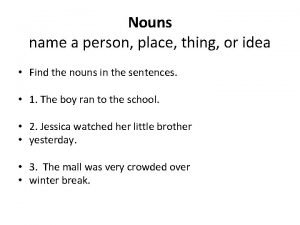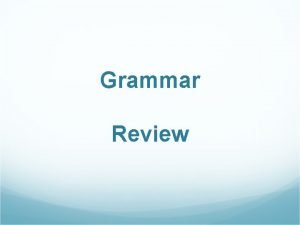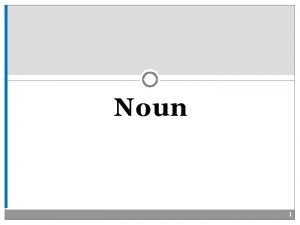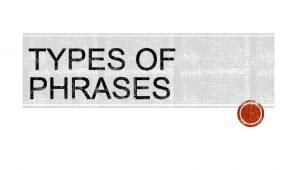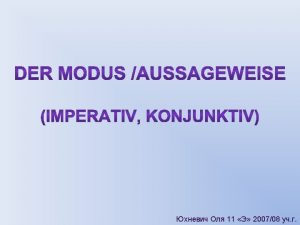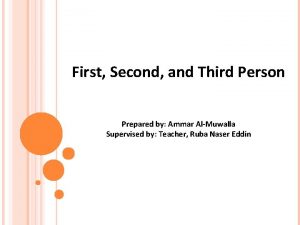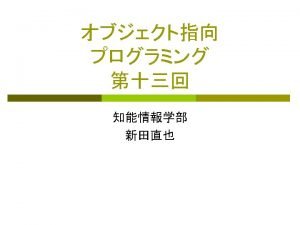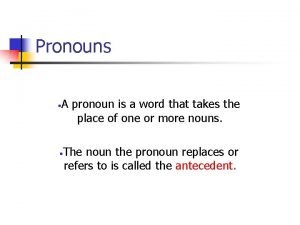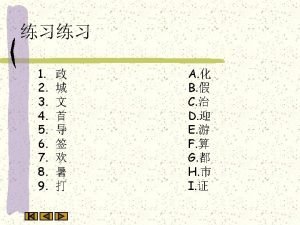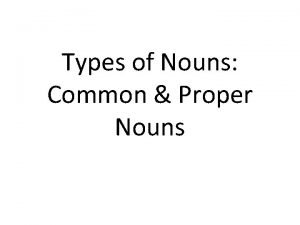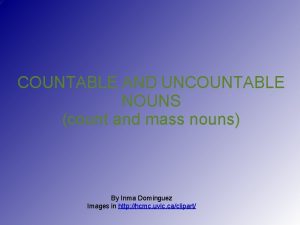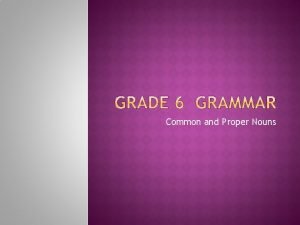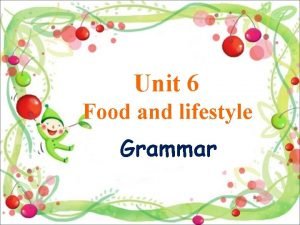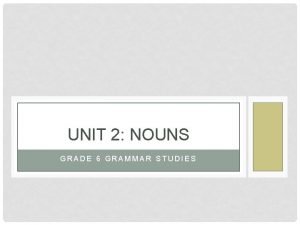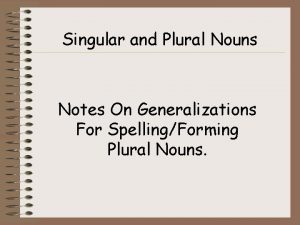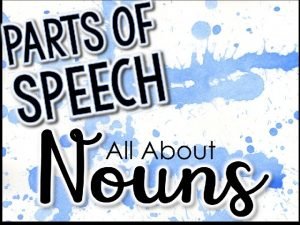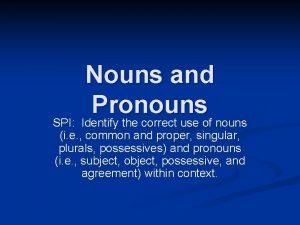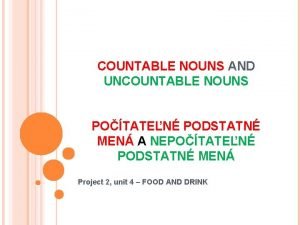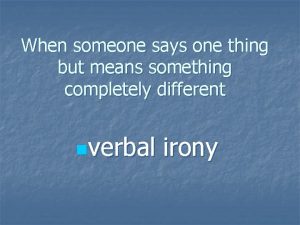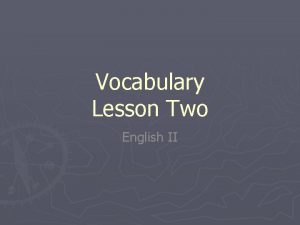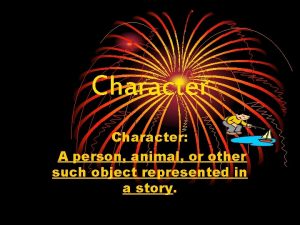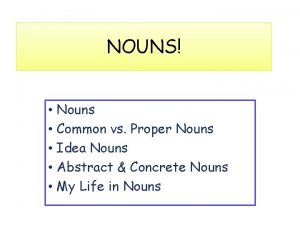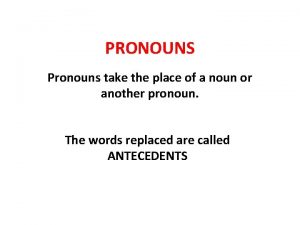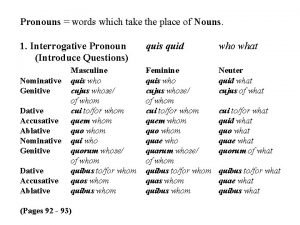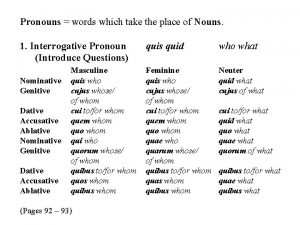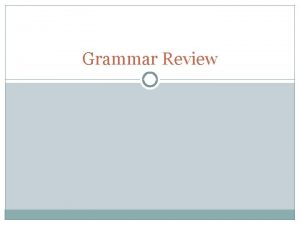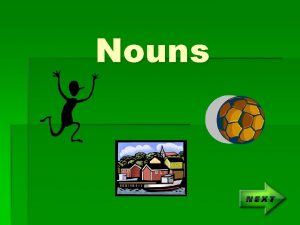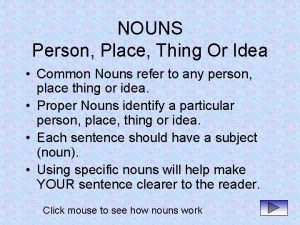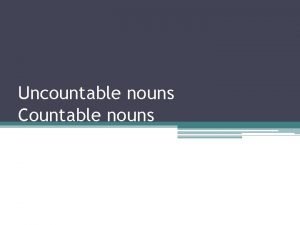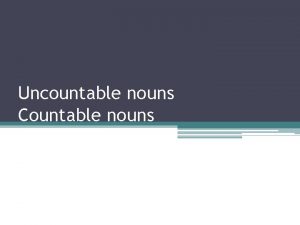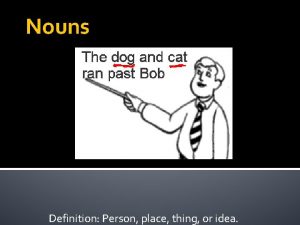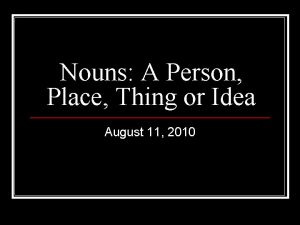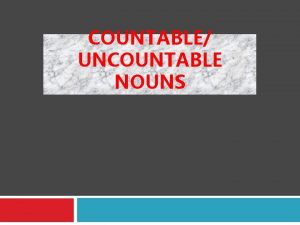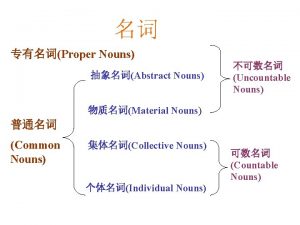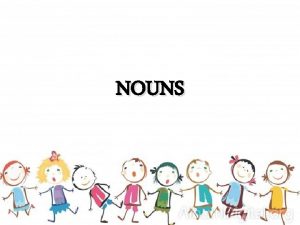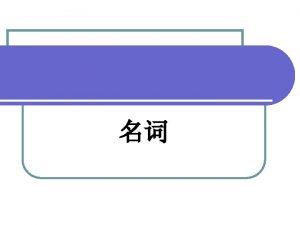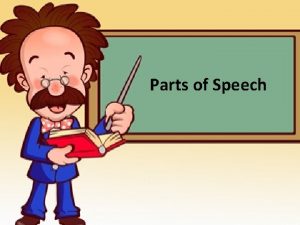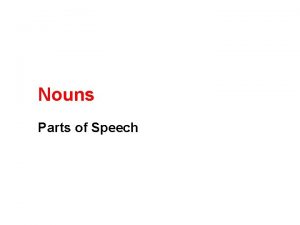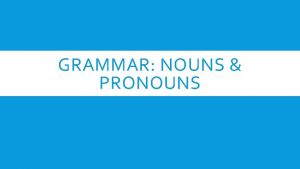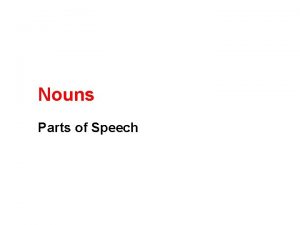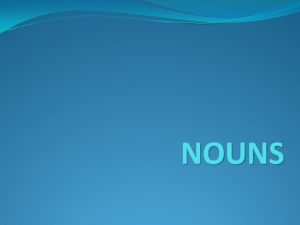Hurray Nouns n Person place thing idea Can






























- Slides: 30

(Hurray!)

Nouns (n) Person, place, thing, idea Can be subjects, or just hanging out

Verbs (v) Show Or action state of being Is, am, were, was, are, being, been

Adjective Describe (modify) nouns or pronouns A, an, the = articles

�Adverbs � Modify verbs, adjectives, or other adverbs � Answer the questions how, when, where, or to what extent � Often end in -ly

Prepositions Show (p) relationships between words “The bird flew ___ the clouds”

�All prepositions are in prepositional phrases � Begin with preposition � End with first noun or pronoun that follows it � The noun/pronoun is called the object (op)

Pronouns Take (pr) the place of a noun The noun that is being replaced is called the antecedent

�There are different types of pronouns �Personal Pronouns First, second, and third person �I, me, we �You, yours �He, she, them, theirs, it

Also, there are Indefinite pronouns Relative pronouns (we’ll discuss more later…)

�Conjunctions (c) �Show connections Coordinating conjunctions �And, but, or, yet, so �Use in compound sentence parts and compound sentences

Subordinating conjunctions �Begin dependent (subordinate) clauses MANY of these! Used in complex and compound-complex sentences

Interjections (i) Interrupt the sentence; usually show emotion Hey! Shut the door!

�Declarative (. ) – makes a statement �Interrogative (? ) – asks a question �Exclamatory (!) – shows emotion �Imperative (!/. ) – makes a command has an understood “you” subject

Simple One sentence subject, one verb, one complete thought (But either the subject or verb may be compound)

Example: Joe washed the car. Notice order: S V

Example w/compound parts Subject: Joe and Sue washed the car. Verb: Joe washed and waxed the car.

Example Subject continued. . & verb: Joe and Sue washed and waxed the car.

�Notice in all examples, the order of subject verb is consistent: S V, S V V, or S S V V �The sentences cannot be divided at the conjunction into two complete thoughts!

�Compound � At Sentence least two subjects, two verbs, and two complete thoughts � Example: Joe washed the car, and Sue drove it to town.

Notice the order of a compound sentence: S V SV It can be divided at the conjunction into two complete thoughts

� As with a simple sentence, any part of the subject or verb of either clause of a compound sentence can be compound! �Joe and Sue washed and waxed the car, and Bob and Jane drove it to town and parked it at the restaurant.

� Complex sentence �At least two subjects, at least two verbs, one complete thought and one incomplete thought �Example: After Joe washed the car, Sue drove it to town.

Notice that like in a compound sentence, the order is S V Notice, too, that there is no coordinating conjunction

�Instead, there is a subordinating conjuction �Begins the dependent (or subordinate) clause �If removed, dependent clause is no longer dependent!

� The dependent clause can come anywhere in the sentence and is punctuated differently depending on where it is: �At beginning, followed by comma ( S V, S V) �In middle, set off by commas on each side (S, S V, V) �At end, no comma (S V S V)

� As with simple and compound sentences, any part of the subject or verb of either (or all) clauses may be compound; this does NOT make it a compound-complex sentence!

� Compound-complex sentence �Combination of a compound and complex structure At least three subjects, at least three verbs, at least two complete thoughts, at least one incomplete thought

Example: After Joe washed the car, Sue drove it to town, and Sam got in for a ride.

Copy the sentence; you’re looking for the number of things indicated by the points possible Identify all parts of speech and objects Find the main verb; underline twice Ask yourself “Who” or “What” did the main verb = subject; underline once Determine sentence structure Determine sentence type Volunteer Correct your own when I correct Ask questions!
 Noun person place thing or idea
Noun person place thing or idea Person, place, thing, or idea
Person, place, thing, or idea Person, place, thing examples
Person, place, thing examples Compound nouns kitchen
Compound nouns kitchen Noun person place thing or idea
Noun person place thing or idea The theme is the central idea and insight of the text.
The theme is the central idea and insight of the text. Noun phrase of dog
Noun phrase of dog A noun is a person place or thing
A noun is a person place or thing 1 person plural
1 person plural Examples of first second and third person
Examples of first second and third person Person person = new person()
Person person = new person() I, you, he, she, it, we, they sentences
I, you, he, she, it, we, they sentences Place thing
Place thing Bread countable or uncountable
Bread countable or uncountable Shelf is common or proper noun
Shelf is common or proper noun Mass nouns clipart
Mass nouns clipart Common and proper nouns paragraph
Common and proper nouns paragraph Lifestyle countable or uncountable
Lifestyle countable or uncountable Nouns grade 6
Nouns grade 6 Singular and plural with es
Singular and plural with es Pig common or proper noun
Pig common or proper noun Plural nouns y gender nouns
Plural nouns y gender nouns Proper nouns
Proper nouns Countable nouns
Countable nouns When a person says one thing but means another
When a person says one thing but means another The actors gathered in the banquet room
The actors gathered in the banquet room Person or animal who takes part in the action of the story
Person or animal who takes part in the action of the story Abstract noun and concrete noun worksheet
Abstract noun and concrete noun worksheet Pronouns take the place of
Pronouns take the place of Pronouns take the place of nouns
Pronouns take the place of nouns Take the place of nouns
Take the place of nouns

